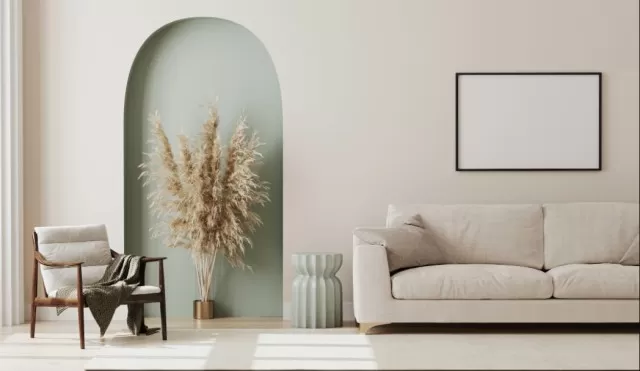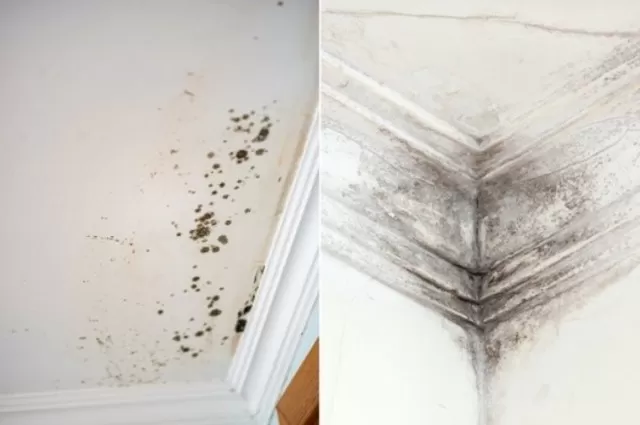Mold and Mildew are types of fungi that thrive in moist environments. The difference between them is minimal, with mildew being an early stage of mold.
While both fungi play a vital role in breaking down organic matter like leaves, benefiting the soil, certain types of mold and mildew can be harmful to human health.
Living in a mold-infested environment can lead to serious health issues, including headaches, respiratory problems, sinus congestion, and irritation of the eyes, nose, or throat. Infants, children, pregnant women, the elderly, and individuals with existing respiratory conditions are particularly vulnerable to these health risks.
Remove Mold and Mildew from Outdoor Fabric

How to Remove Mold and Mildew from Outdoor Fabric.
- Take Upholstered Pieces Outside. To prevent spreading mold spores indoors, begin by moving fabric and upholstery outside whenever feasible. Prior to cleaning, gently brush off as much mildew as possible.
- Soak and Wash the Fabric. Launder the moldy or mildewy fabric using chlorine bleach and hot water. If the material is not compatible with chlorine bleach, opt for oxygen bleach instead. Soak the fabric in a mixture of oxygen bleach and hot water for approximately 30 minutes, then wash it according to the care instructions.
- Dry the Fabric. Whenever possible, dry the laundered fabric outdoors in direct sunlight. The sun’s natural UV rays can aid in killing any remaining mold or mildew and help freshen the fabric.
By following these steps, you can effectively clean mold and mildew from outdoor fabric, promoting a healthier and more pleasant outdoor environment.
Remove Mold and Mildew from Indoor Fabric

How to Remove Mold and Mildew from Indoor Fabric
If you’re unable to move certain items outdoors, you can follow these steps to clean upholstered items indoors:
- Vacuum the Upholstery. Begin by vacuuming the upholstered item thoroughly. If possible, replace the vacuum bag or empty the canister outside to prevent spreading mold spores indoors.
- Clean with an Ammonia Solution. Create a mixture of one cup of ammonia and one cup of cool water. It’s important to note that chlorine bleach and ammonia should never be combined, as it can result in toxic fumes.
Using a clean, white cloth, sponge the stained areas with the ammonia solution. Blot the fabric gently until all the liquid is absorbed. Repeat the process as needed until the stain disappears. - Blot and Dry. After treating the stains with the ammonia solution, sponge the area with cold water to remove any residue. Blot the fabric gently to remove excess moisture. Finally, ensure thorough drying by using a fan or setting a hair dryer on the cool setting.
By following these steps, you can effectively clean mold and mildew from indoor fabric, helping to maintain a clean and mold-free environment indoors.
Cleaning Mildew-Stained Carpets

Cleaning Mildew-Stained Carpets
Follow these steps to effectively clean mildew-stained carpets and restore their freshness:
- Vacuum the Carpet. Begin by thoroughly vacuuming the affected carpet to remove as much mildew as possible. After vacuuming, either dispose of the vacuum bag or clean the canister outside to prevent the spreading of the mildew spores indoors.
- Apply Cleaning Solution and Dry. In a brisk motion, mix 1 tablespoon of liquid laundry soap with 2 cups of cool water. Apply the resulting suds to the stained area using a damp cloth.
Gently sponge the affected area, repeating the process until the stain is completely gone. Afterward, rinse the area with clean water. Finally, ensure the carpet dries completely.
By following these steps, you can effectively clean mildew-stained carpets, helping to eliminate odors and restore the carpet’s appearance.
Removing Mildew from Wood Furniture

Removing Mildew from Wood Furniture
If your wood furniture is affected by mildew, it’s important to give it a thorough cleaning. Follow these steps to remove mildew from wood furniture:
- Vacuum the Furniture. Begin by using a soft brush attachment on your vacuum cleaner to gently remove any loose mildew spores from the wood furniture. After vacuuming, either dispose of the vacuum bag or clean the canister outside to prevent the spreading of the spores indoors.
- Wipe and Polish. Swiftly wipe off any visible mildew stains from the furniture using a light touch.
Dampen a cloth with water and gently rinse the affected area. Allow the wood to dry completely, and then apply a suitable wood polish to restore its shine and protect the surface.
By following these steps, you can effectively remove mildew from wood furniture and restore its appearance. Remember to take necessary precautions to prevent the spread of spores during the cleaning process.
Preventing Mold and Mildew

Preventing Mold and Mildew in the Bathroom
The bathroom is prone to high levels of moisture and humidity, making it a common breeding ground for mold and mildew. To prevent their growth, follow these steps to maintain a fresh and mold-free bathroom:
- Ensure Proper Ventilation. One of the most important preventive measures is to ensure your bathroom is well-ventilated.
Install an exhaust fan to circulate the air and remove moisture effectively. Run the fan during and after showering to reduce humidity levels. - Spread Out Towels. After use, spread out towels in the bathroom to allow them to dry more quickly. Hanging them up properly helps prevent moisture buildup and inhibits mold and mildew growth.
- Minimize Shower Clutter. Reduce the number of containers left in the shower to improve circulation and ease of cleaning. Clutter can hinder proper air circulation, creating an environment conducive to mold and mildew growth.
- Wipe Down the Shower. After each use, wipe down the shower walls and surfaces with a clean towel or squeegee. This helps remove excess water and prevents moisture from lingering, reducing the chances of mold and mildew formation.
- Choose Suitable Shower Curtains. Opt for shower curtains that are easy to clean and dry quickly.
Avoid curtains that trap moisture or accumulate soap residue, as this can provide a breeding ground for mold and mildew. Consider using a washable and mildew-resistant shower curtain liner for added protection.
By implementing these preventive measures, you can significantly reduce the risk of mold and mildew growth in your bathroom, maintaining a clean and healthy environment.
Preventing Mold and Mildew Throughout the House
To maintain a mold and mildew-free home, follow these preventive measures:
- Control Moisture Levels. Use dehumidifiers, fans, and open windows to reduce moisture levels in your home. Pay special attention to hot and humid months when moisture accumulation is more likely.
- Fix Plumbing Leaks Promptly. Address plumbing leaks as soon as they are detected. Even minor leaks can contribute to moisture buildup and create an environment favorable for mold and mildew growth.
- Prevent Water Seepage. Regularly check for potential problem areas where rainwater could seep into your home, such as roof leaks, damaged gutters, or improperly sealed windows and doors.
Take necessary steps to prevent water intrusion and promptly address any issues that arise. - Clean and Dry Fabrics. Regularly clean fabrics in your home, such as curtains, upholstery, and carpets, to prevent mold and mildew growth. Ensure they are completely dry after cleaning or in case of spills.
- Store Items Properly. Store belongings in dry and well-ventilated areas.
Avoid storing items in damp basements or areas prone to moisture. Use moisture-absorbing products like silica gel packs or dehumidifiers in storage spaces if necessary.
By following these preventive measures, you can minimize the risk of mold and mildew growth throughout your home, promoting a healthier living environment.
*The information is for reference only.